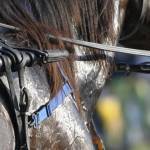Hot Weather Hazard for Horses

Most horse owners know they shouldn’t work their horses quite as hard in very hot, humid conditions as they might in a cooler season. Dropping back on exercise level, changing one long training period to two shorter ones each day, and working in the coolest part of the day are ways to avoid overheating horses during the summer months.
In very hot, humid weather, horses can develop signs of heat exhaustion even if they aren’t being ridden. When conditions are extreme, they simply can’t sweat enough to cool their bodies sufficiently. Older horses and obese animals are at increased risk.
Heat exhaustion can develop in pastured or stalled horses as well as those that have been exercised. One of the most obvious signs of heat exhaustion is an elevated respiration rate; the horse appears to be panting, possibly with so much effort that his whole body rocks with each breath. Heart rate will be elevated, sweating may be extreme, and the horse’s muscles can begin to quiver. You might also see signs more typical of colic, such as horses throwing themselves onto the ground and rolling.
Horses showing signs of heat exhaustion should have any tack removed and then be taken to a cool, breezy place and hosed with cold water. Continue hosing until the respiration rate becomes normal (about 10 to 12 breaths per minute). Provide cool, fresh water to drink. Give electrolytes only if the horse is consuming plenty of water. If the horse doesn’t respond quickly to this treatment by showing a significant drop in respiration rate, call a veterinarian.
To minimize the chance of heat exhaustion, don’t work horses hard in extreme temperatures, and ride early in the morning before the day gets too hot. Provide all horses with shade, fresh drinking water, and moving air (natural breeze or a fan). Check all horses frequently during extremely hot, humid weather.
 When horses lose sweat they lose electrolytes, with the principal losses being chloride, sodium, potassium, and magnesium. If these essential nutrients are not replenished, the consequences may include dehydration, muscular weakness, overheating, fatigue, and poor performance. Developed by Kentucky Equine Research (KER), Restore® SR and Restore® Paste replace these essential nutrients. Using advanced equine electrolyte technology, Restore SR allows sodium to be gradually released into the gastrointestinal tract for sustained absorption. Restore Paste is easy to administer and features a buffering agent designed to support gastrointestinal comfort in horses.
When horses lose sweat they lose electrolytes, with the principal losses being chloride, sodium, potassium, and magnesium. If these essential nutrients are not replenished, the consequences may include dehydration, muscular weakness, overheating, fatigue, and poor performance. Developed by Kentucky Equine Research (KER), Restore® SR and Restore® Paste replace these essential nutrients. Using advanced equine electrolyte technology, Restore SR allows sodium to be gradually released into the gastrointestinal tract for sustained absorption. Restore Paste is easy to administer and features a buffering agent designed to support gastrointestinal comfort in horses.








